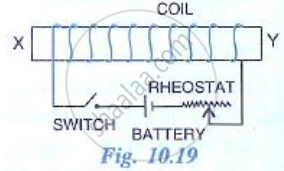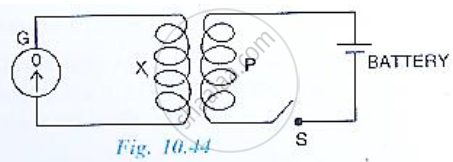Advertisements
Advertisements
प्रश्न
Distinguish between Step up and Step Down Transformer.
उत्तर
| No. | Step-up transformer | Step-down transformer |
| i. | The number of turns in its secondary is more than that in its primary (NS > NP). | The number of turns in primary is greater than secondary (NP > NS). |
| ii. | The alternating voltage across the ends of its secondary is more than that across its primary i.e., eS > eP | The alternating voltage across the ends of the primary is more than that across its secondary i.e., eP > eS |
| iii. | Transformer ratio K > 1. | Transformer ratio K < 1. |
| iv. | Primary coil made of thick wire. | Secondary coil made of thick wire. |
| v. | The secondary coil is made of thin wire. | The primary coil is made of thin wire. |
| vi. | Current through secondary is less than primary. | Current through primary is less than secondary. |
APPEARS IN
संबंधित प्रश्न
State the principle on which transformer works.
Derive an expression for e.m.f. and current in terms of turns ratio
State the principle of the step-down transformer and its working.
Find the ratio of primary and secondary currents in terms of turn ratio in an ideal transformer.
State the principle of transformer working with the help of a diagram
Mention various energy losses in transformer device
Why is the core of a transformer laminated?
You are required to make an electromagnet from a soft iron bar by using a cell, an insulated coil of copper wire and a switch. (a) Draw a circuit diagram to represent the process. (b) label the poles of the electromagnet.
The adjacent diagram shows a coil would around a soft iron bar XY. (a) State the polarity at the end X and Y as the switch is pressed. (b) Suggest one way increasing the strength of electromagnet so formed.

State two ways through which the strength of an electromagnet can be increased.
Explain why an induced current must flow in such a direction so as to oppose the change producing it.
The following diagram in Fig. 10.44 shows a coil X connected to a sensitive centre –zero galvanometer G and a coil P connected to a battery through a switch S.

(a) Describe the observation when the switch S is (i) closed suddenly, (ii) then kept closed, (iii) finally opened.
(b) Name and state the law which explains the above observations.
The secondary windings of a transformer in which the voltage is stepped down are usually made of thicker wire than the primary. Explain why.
The transformer is used in ______ current circuits.
What is the function of a transformer in an a.c. circuit? How do the input and output powers in a transformer compare?
Name two kind of energy loss in a transformer. How is it minimized?
A transformer is designed to work from a 240 V a.c. mains and to give a supply of 8 V to ring a house bell. The primary coil has 4800 turns. How many turns will be in the secondary coil?
Given the input current 15 A and the input voltage of 100 V for a step-up transformer having 90% efficiency, find the output power and the voltage in the secondary if the output current is 3 A.
A transformer is used to step up an alternating emf of 200V to 440V. If the primary coil has 1000 turns, calculate the number of turns in the secondary coil.
Can a transformer be used with direct current source? Give reason.
State the factors on which the frequency of the alternating e.m.f. depends.
A circular coil of 100 turns with a cross-sectional area of 1 m2 is kept with its plane perpendicular to the magnetic field of 1 T. The magnetic flux linkage is ______.
An ideal transformer has 100 turns in the primary and 250 turns in the secondary. The peak value of the AC is 28 V. The rms secondary voltage is nearest to ______
The primary of a transformer has 40 turns and works on 100 V and 100 W. Find a number of turns in the secondary to step up the voltage to 400 V. Also calculate the current in the secondary and primary.
State whether true or false. If false, correct the statement.
A transformer can step up direct current.
In a transformer, the number of turns in the primary and the secondary are 410 and 1230 respectively. If the current in primary is 6A, then that in the secondary coil is
A step-down transformer reduces the supply voltage from 220 V to 11 V and increase the current from 6 A to 100 A. Then its efficiency is
In a series resonant RLC circuit, the voltage across 100 Ω resistor is 40 V. The resonant frequency ω is 250 rad/s. If the value of C is 4 µF, then the voltage across L is
Explain the working of the transformer.
Give the advantage of AC in long distance power transmission with an illustration.
Find out the phase relationship between voltage and current in a pure inductive circuit.
A step-down transformer connected to the main supply of 220 V is used to operate 11V,88W lamp. Calculate
- Voltage transformation ratio and
- Current in the primary
A 200V/120V step-down transformer of 90% efficiency is connected to an induction stove of resistance 40 Ω. Find the current drawn by the primary of the transformer.
The 300 turn primary of a transformer has resistance 0.82 Ω and the resistance of its secondary of 1200 turns is 6.2 Ω. Find the voltage across the primary if the power output from the secondary at 1600V is 32 kW. Calculate the power losses in both coils when the transformer efficiency is 80%
The output power in step-up transformer used in practice is ______.
A 220 V input is supplied to a transformer. The output circuit draws a current of 2.0 A at 440 V. If the ratio of output to input power is 0.8, then the current drawn by primary winding is ______.
Assertion: A transfonner cannot work on D.C. supply.
Reason: D.C. changes neither in magnitude nor in direction.
A transformer is essentially an a.c. device. It cannot work on d.c. It changes alternating voltages or currents. It does not affect the frequency of a.c. It is based on the phenomenon of mutual induction. A transformer essentially consists of two coils of insulated copper wire having different numbers of turns and wound on the same soft iron core.
The number of turns in the primary and secondary coils of an ideal transformer is 2000 and 50 respectively. The primary coil is connected to a main supply of 120 V and secondary coil is connected to a bulb of resistance 0.6 Ω.
The value of voltage across the secondary coil is ______.
Define a Transformer.
The primary winding of a transformer has 100 turns and its secondary winding has 200 turns. The primary is connected to an a.c supply of 120 V and the current flowing in its is 10 A. The voltage and the current in the secondary are ______.
For an LCR circuit, the power transferred from the driving source to the driven oscillator is P = I2Z cos φ.
- Here, the power factor cos φ ≥ 0, P ≥ 0.
- The driving force can give no energy to the oscillator (P = 0) in some cases.
- The driving force cannot syphon out (P < 0) the energy out of oscillator.
- The driving force can take away energy out of the oscillator.
The line that draws power supply to your house from street has ______.
- zero average current.
- 220 V average voltage.
- voltage and current out of phase by 90°.
- voltage and current possibly differing in phase `phi` such that `|phi| < pi/2`.
An ideal transformer converts 220 V a.c. to 3.3 kV a.c. to transmit a power of 4.4 kW. If primary coil has 600 turns, then alternating current in secondary coil is ______.
The large scale transmission of electrical energy over long distances is done with the use of transformers. The voltage output of the generator is stepped-up because of ______.
Efficiency of transformer is the ratio of ______.
What type of transformer is used in a mobile phone charger?
For what purpose are the transformers used?
How do the input and output powers in a transformer compare? State the assumption made.
